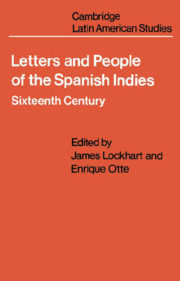Book contents
- Frontmatter
- Contents
- Preface
- Part I Conquest
- Part II The Variety of Life in the Indies
- 11 An encomendero's establishment
- 12 An encomendero's opinions
- 13 The miner
- 14 Commerce across the Atlantic
- 15 The professor of theology
- 16 The new arrival
- 17 The tanner and his wife
- 18 The troubadour
- 19 The nephew
- 20 The garden and the gate
- 21 The woman as settler
- 22 The farmer
- 23 The petty dealer
- 24 The Flemish tailors
- 25 The nobleman
- 26 The Hispanized Indian
- 27 Indian high society
- 28 An Indian town addresses the king
- Part III officials and Clerics
- Bibliography
- Index
27 - Indian high society
from Part II - The Variety of Life in the Indies
Published online by Cambridge University Press: 06 August 2018
- Frontmatter
- Contents
- Preface
- Part I Conquest
- Part II The Variety of Life in the Indies
- 11 An encomendero's establishment
- 12 An encomendero's opinions
- 13 The miner
- 14 Commerce across the Atlantic
- 15 The professor of theology
- 16 The new arrival
- 17 The tanner and his wife
- 18 The troubadour
- 19 The nephew
- 20 The garden and the gate
- 21 The woman as settler
- 22 The farmer
- 23 The petty dealer
- 24 The Flemish tailors
- 25 The nobleman
- 26 The Hispanized Indian
- 27 Indian high society
- 28 An Indian town addresses the king
- Part III officials and Clerics
- Bibliography
- Index
Summary
Don Pedro Enrique Moctezuma, in Mexico City, to his relatives dona Magdalena Axayaca, dona Petronila Pimentel, and dona Bar-bola de la Concepcion, in nearby Iztapalapa, 1587
… Ma yehuatzin Spu Sancto ytlan moyetztie yn cenca mahuiztic amotlaJoanimantzin tlas;ocihuapipiltine …
May the Holy Spirit dwell in your very honored precious souls, dear ladies …
If all Indian rulers were ‘caciques,’ still there were some distinctions recognized by the Spaniards. Encomiendas, pensions and honorific titles went to a few direct descendants of Moctezuma in Mexico, and of Atahuallpa and Huascar in Peru. And aside from the question of Spanish recognition, a corps of high nobility maintained itself in and around each of the former imperial centers, Mexico City and Cuzco, even after decimation in the conquest. For a century or more these groups continued to exist in important Spanish cities, quite well received by the Spaniards, sometimes marrying into Spanish society at a high level, yet long retaining a self-awareness and distinct life style. In Peru, since Quechua was rarely written down, the nobles tended to do their writing in Spanish. But the nobles of Mexico, where after the conquest literacy in Nahuatl was widespread, have left us chronicles and correspondence in their own tongue.
Our main purpose here is to give the reader some rough notion of the refined, elegant, hyperflorid tone of these people's discourse, still very much that of the preconquest Aztec nobility despite the integration of Spanish terms and concepts - a rough notion, we say, because the English is a pale reflection of the parallelisms, circumlocutions and multiple reverentials which the richness of the Nahuatl allows without artificiality or coyness.
Some dynastic background will be necessary for understanding. The only son of Emperor Moctezuma to live on into the Spanish period, at least the only one enjoying recognition, was don Pedro Moctezuma. He received the encomienda of Tultengo in the Tula district and owned considerable property, including a large house on the square of San Sebastian, the northeastern district of Mexico City. A series of royal decrees conHrmed his rights and gave him a large pension besides. On his death, his legitimate son don Martin Moctezuma succeeded. As this letter is written, don Martin has also died, and there is great controversy over the succession.
- Type
- Chapter
- Information
- Letters and People of the Spanish IndiesSixteenth Century, pp. 160 - 162Publisher: Cambridge University PressPrint publication year: 1976



